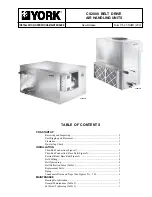
Page 16
Operation and Maintenance
Envistar Top 04-21
DSET.190501.01.EN
Continuous product development may give rise to specification changes without notice.
Cooling circuit function
Cooling mode
From the compressor (1), the refrigerant is pushed as hot gas to the condenser
(the extract air coil) where the heat is emitted. The refrigerant condenses from
gas to liquid when it is cooled by the extract air.
The refrigerant passes the pressure reducing expansion valve (4) and undergoes
a phase transformation in the evaporator from liquid to gas (the refrigerant
evaporates).
Inside the evaporator (the supply air coil), the refrigerant absorbs the heat
required for phase transformation. The heat is taken from the supply air which is
thus cooled.
The cold refrigerant in gaseous form is drawn back into the compressor (1),
where it is compressed and thus heated. The gas is also used for cooling the
compressor’s electric motor. The refrigerant now contains the heat from the
supply air, the compressor’s motor heat and the compression heat.
Flow chart for refrigerant system
Heating mode
The function of heating mode is similar to that of cooling mode. The difference
between the cooling and heating modes is that the 4-way valve is in the
heating position. This means that the extract air coil, which was a condenser in
cooling mode, is now an evaporator. Conversely, the supply air coil becomes a
condenser.
8
3
9
11
13
14
10
15
17
18
16
4
1
5
6
2
12
7
1 Compressor
2
Suction gas sensor (temp after evaporator)
3
Pressure sensor, low pressure
4
Expansion valve
5
Frequency inverter
6
4-way valve
7
High pressure switch
8
Pressure sensor, high pressure
9
Temperature sensor, hot gas
10
Temperature sensor liquid line cooling
11
Temperature sensor liquid line heating
12
Temperature sensor sump
13
Extract air coil (condenser/evaporator)
14
Supply air coil (condenser/evaporator)
15
Exhaust air
16
Extract air
17
Outdoor air
18
Supply air






































